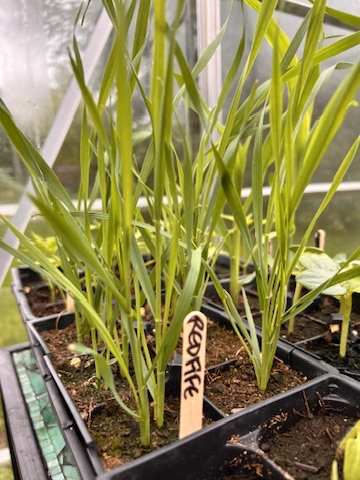by Mara Welton, director of programs

Happy spring everyone — we made it! It has been so fun to see the posts from recipients across social media platforms as you have received your 2024 Plant a Seed kits featuring roots and grains.
Up here in the Northeast, it is alternating sunny and rainy days, which has been encouraging growth in my garden. I am particularly excited to be growing grains along with all of you this year on a garden scale! You might be wondering why we chose grains for the seed kit this year. I think a lot of people don’t ever consider grains as something you might grow in a garden. Humans have been working in collaboration with these powerful crops for millennia, encouraging adaptation to our geographical ecosystems, including our gut microbiomes!

Director of Programs Mara Welton
Grains are one of the important crop groups represented in the Plant a Seed kits this year – we have been considering crops through the lens of nutrition and climate for the past eight years of this program. Let’s take a moment to consider the importance of grains and how you can engage with them this year in your own gardens! The grain seeds that we chose to feature in the Plant a Seed kit this year are Purple Karma barley, Coral sorghum, Cocke’s Prolific corn, and Red Fife wheat.
What is the connection of these grains to our human health, planetary health and climate health? As someone who battles insulin resistance, I am so grateful to whole grains and their role in human nutrition, not just for the benefits to gut health, but whole grains are powerful when it comes to stabilizing blood sugar. Whole grains have considerable amounts of bran and dietary fiber, which are crucial elements to evening out glucose spikes, which really helps to keep inflammation and inflammatory diseases like diabetes at bay. Our gut houses billions of microbes that help us digest and absorb nutrients, which leads to general digestive and overall health. Whole grains are some of our gut microbes’ most favorite foods. When you are eating grains, you are actually feeding the microbes in your gut! When you soak grains, you unlock their nutritional power, so consider soaking your rice or wheat berries for 4+ hours before draining and cooking. Remember, grains are seeds, and when you soak them you are essentially sprouting them, and the act of sprouting grains makes all the nutrients more bio-available! Some grains like barley are particularly helpful for insulin support; they grow quickly and are prolific on a garden scale. This was the first grain I planted in my garden this year and I cannot wait to harvest and cook it!

Purple Karma barley

Cocke’s Prolific corn

Red Fife wheat

Coral sorghum
Not only do grains advocate for human health as a part of a diverse diet, but grains and growing grains can be a very important contributor to positive climate impact. Our land is covered in monocrop megafarms: think amber waves of grain across the Midwest with hundreds and hundreds of acres of all manner of grains. This use of grains removes them from their key role in a biodiverse, bio-intensive small-scale agricultural relationship with land. Many regenerative agriculture farmers use small plots of grains in rotation with their market crops in key ways that position grains as powerful climate-positive allies. One way grains are used in regenerative agriculture is to stabilize soils with their root systems, keeping essential water and soil composition intact. Many trials are happening right now that have identified grains like rye as particularly useful in this regard. The root systems of grains can help tremendously in fighting erosion in fragile ecosystems. Complex root systems of grains are essential in maintaining soil structure and prevention of erosion.
Another way grains are used in regenerative agricultural practices is to build soils. Many grains are used in cover-cropping systems, keeping soil from eroding but also using grain foliage as a green manure, powerfully assisting in pulling carbon from the atmosphere and returning it to the soil if mowed down and worked back into the soil to feed soil microbes. Other farmers use grain crops on a rotational basis to help maintain positive water retention in agricultural fields.
Even growing grains on a very small scale can yield huge results, and It’s one goal of the Plant a Seed campaign to provide an opportunity for growers in the Slow Food Network to see this magic firsthand in their own gardens! Throughout this season, I would love to hear how growing grains is going for you:
- How has growing grains in your gardens impacted your relationship with sourcing your food from your own backyard?
- Do you notice more biodiversity as a result of having grains growing in your gardens?
- Are you planning on chopping up your grain stalks and returning them to your soil to build carbon in the fall?
- What are your grain yields?
- How do they taste?
- How are you using them in cooking?
Email me at plantaseed@slowfoodusa.org to start a conversation with me about your Plant a Seed experience! Please post pics of your gardens! We’d love to see your grains growing and how you are using them every step of the way! Tag us at @slowfoodusa and #plantaseed2024
As we approach the International Day for Biological Diversity and our own Biodiversity Advocacy Day, and as you grow your biodiverse Plant a Seed gardens this year, I hope you’re feeling more connected to the plants around you, their roles in our nutrition and how they contribute to a healthy planet. Happy growing!

